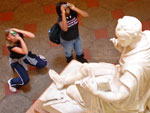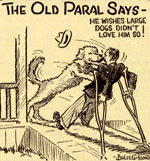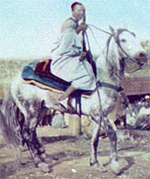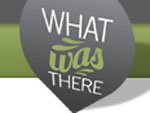National Portrait Gallery: Teaching with 19th-Century Portraits
Briana Zavadil White of the National Portrait Gallery introduces TAH teachers to portraits of inventors and presidents from the 19th century, inviting teachers to ask questions and form hypotheses.
Briana Zavadil White: So, within the education department what we do is we use the portrait as a springboard into a conversation about history and biography, because the Portrait Gallery considers itself to be a biography, history, and art museum. So the art, the portrait, is always our focus, yet we're using that to get into a much deeper conversation.
The activity that we like to do is called a puzzle activity. You will need to share, and some of you will get your own. All right, this is what I would like you to do. In your pairs, or individually—depending on if you have a pair or you're working individually—just look at your puzzle piece, and try to identify what it is that you see. You're not trying to put the puzzle together yet, because we will get to that point; don't share with another group what it is that you have, just identify what it is that you're looking at. Okay? And then we'll go through in just a second.
[One group converses]
Speaker 1: [Unintelligible]
Speaker 2: It makes him seem really easy and relaxed.
Speaker 1: And interested in what he's saying. The other person over there, it's like he's not party to that conversation.
Speaker 2: Right, like he's focused on something else over here.
Speaker 1: Doesn't that look like he's looking at—maybe the city—
Briana Zavadil White: Just identify to the group what it is that you saw, but not showing anybody else your puzzle piece. Okay? Okay?
Speaker 1: Levers, wheels, some type of transportation tool? Lots of wood, and lots of levels—platforms—made of wood.
Speaker 2: We had a rug, a couple shoes—with feet and pant legs. And a map, or sketch of a building unrolled on the floor.
Speaker 3: I had what looks to be a blueprint sitting on an end table with a red rug on the floor.
Speaker 4: We have a meeting; there are many men involved. Two men are having an aside—one is turned to the other listening. There's something strange on the table, a metallic device, it looks like it's got tape through it; so we were wondering if it’s a telegraph receiver or something.
Briana Zavadil White: What do we know for certain about this portrait?
Speaker 5: That it's a formal affair.
Speaker 6: The signing of the Declaration of Independence or something?
Speaker 7: There's no women.
Briana Zavadil White: So it's a meeting, there's no women, it’s a formal affair, the signing of perhaps the Declaration.
Speaker 8: They look like prominent, powerful men; they have authoritative dress.
Briana Zavadil White: Okay, so their clothing is telling us that—again, this idea of formality—but also that they are prominent gentlemen.
Speaker 9: Movers and shakers.
Briana Zavadil White: We talked about the rug, there's some red drapery, right? And the marble pillars.
Speaker 10: There's the Franklin portrait.
Briana Zavadil White: There's the Franklin portrait.
Speaker 10: Which would mean that it's not the Declaration of Independence signing, but maybe it's inventors or industrialists.
Speaker 11: Maybe the period of Enlightenment, invention, science.
Briana Zavadil White: And you had said mid-19th century. Why did you say that?
Speaker 12: The clothing.
Speaker 13: No powdered wigs.
Speaker 12: The dark black coats that seemed to have been popular around that time.
Briana Zavadil White: Okay, okay. What do you want to do with it?
Speaker 13: Put it together?
Briana Zavadil White: Why don't we do it right there, in that open space?
[Attendees assemble puzzle]
Briana Zavadil White: What's the big "so what?" of a puzzle activity?
Speaker 14: If you did it with a class, they'd be questioning where things go, where things are placed, what's the significance of observing.
Briana Zavadil White: Okay, so observation [and] visual thinking. What else?
Speaker 15: Spatial awareness of where something's located within something larger.
Briana Zavadil White: Okay, and making inferences. Anything else?
Speaker 16: Working collaboratively.
Briana Zavadil White: The puzzle activity works really well when you choose a portrait that has a lot going on in it, like this piece does. It allows the opportunity to get into the individual pieces, because no one piece doesn't have a lot going on. Even the piece in the corner that sort of looks like a lot of just dark space, I mean, it's still an important piece of the puzzle.
Briana Zavadil White: What do all of these men have in common? Speaker 1: They've got to be inventors. Speaker 2: They're trying to make a decision. Briana Zavadil White: They have to be inventors, they're trying to make a decision. What visually in this portrait is leading you to believe "inventors" and, again, this idea of a meeting and trying to make a decision about something? Speaker 3: Blueprints, models. Speaker 4: Different things, like the gun could be a Colt; just all the different little contraptions, definitely the blueprints, and Franklin again, I think that's— Speaker 5: He's symbolic. Speaker 6: You've got the gentleman pointing at whatever it is, and it looks like the three of them together in the center are pointing at it. They may agree on something and the guy turning across the table to talk to the gentleman behind him…maybe there's two different ideas about what's going on. Speaker 7: I'm wondering though about the men on the left. The lighting is on them so they're significant somehow, but they seem on the fringe of what's going on. So I'm wondering why are they there and what impact do they have? Speaker 8: Or are they just the investors. Briana Zavadil White: Okay, okay. So this is interesting right? You're thinking that perhaps some of these individuals are investors. So again I guess the question would be, what do they allhave in common? Speaker 9: They don't look happy. Briana Zavadil White: Okay. Speaker 10: Well, they're all white males. Briana Zavadil White: What does that tell us? Speaker 10: They are leaders of some industry, because white, and they probably are property owners because they're making a decision and at this timeframe you had to own property to have any kind of power or authority. Briana Zavadil White: What does it say that Ben Franklin is in this portrait, but as a portrait within the portrait? Not physically among them. Speaker 11: It's past his time, but he's influenced the thinking or whatever is going on. Speaker 12: He's pretty much the "Great Inventor." He represents the spirit of inventing. Briana Zavadil White: Okay, so, it's past his time—which is starting to help us date this portrait a little bit; we know we're past 1795. He is above them, again as the Father of Science and Invention—the patron saint. Okay. What else? Speaker 13: This guy in the center is probably one of the lead authority figures in this group because his body is facing toward us, and his body scale is a little larger, seemingly, than some of the other ones—just the width of him. Briana Zavadil White: He's spread out, right? The way that the artist has positioned him we actually see his whole body, not profile. All inventors, right? So, we've got Franklin as the Father of Science and Invention watching over all of these men, okay? One of the reasons why we know that they're all inventors is because—this is when it all fits so nicely together for you as educators—because these men are placed in this portrait with their inventions, with models of their inventions. You've got the Colt Revolver; you've got McCormick's mechanical reaper; you have Goodyear's rubber soled shoes right here. I have had so many conversations—I was just having a conversation this morning with two of the Portrait Gallery's historians, and for the life of us, we just don't know what this is! This is the telegraph. We think that this is a model for a printing press. This is a sewing machine. And the carpet loom. And one of the reasons that we know that we're smack dab in the Civil War for this portrait is the facial hair. Think about it, Abraham Lincoln—with the facial hair—I mean, we're very much in that style. So, you've all been very curious about the individuals, and the lighting, and the way that they're faced, so here's my question to all of you: You are the preeminent inventors of the era; are you all going to have time to come together and have time to sit for your portrait to be painted? Group: No. Briana Zavadil White: No, absolutely not. So what the artist, Christian Schussele, has done in this portrait—just like he did with Washington Irving and his friends at Sunnyside right there—is he sketched them individually from life, so the connection between the artist and the sitter, and then brought them together in his imagination. Okay? So this is why we've got a little bit of strange lighting right here. It's also why most of these men don't necessarily seem to be looking at each other. I mean, they're looking in the same general direction, but it's not as if it's a straight-on conversation.
Speaker 1: It's like a memoir. Like it's telling about his history, not just that moment in time. Speaker 2: Somebody made it to show honor or respect to him. Was he president at the time? When was it painted, like right then or after? Briana Zavadil White: So even though we're seeing "Grant, 1863," the question is: Is this 1863 or not? Is it later? Speaker 3: I think it's later. Briana Zavadil White: It is later, it's 1865. Alright? So when you know that this is Grant at Vicksburg and it's 1865, what does that tell us? Speaker 4: Well, I mean, he was a failure. He was considered a failure in so many different ways. And looking at him, you know, Vicksburg was a big deal; it effectively split the South in two. So it was a big deal. You look at this and Hey, look, I am a— Speaker 5: But I think he looks sad. I don't think he looks like "I am—"; I think he looks sad. Speaker 4: He brought—he pulled himself back up. Speaker 6: The frame is black, and I find that odd—I don't think I've ever seen a frame at all like that. I mean, black is usually mourning. Speaker 7: Black and gold. Briana Zavadil White: My sense is that it's probably meant to contrast with the gold. We've got the acorns referencing oak leaves, and oak leaves are a symbol of strength, right? So it could be it's meant for the battles and for the acorns to stand out. Speaker 8: It's like somebody wants us to know that he's not a guy who just sits around and signs things, he is a man of action and taking charge of whatever. It's all done and now he's in the midst of this mess, not sitting in a tent waiting to hear how it turned out. Speaker 9: And I think his face—I do, I just see this poignancy in his eyes like glory has pain. That's that look in his eye. Speaker 10: The frame and his positioning in the picture makes it seem like he's trying to promote an agenda. Briana Zavadil White: I don’t necessarily know if the portrait was created for him. What I can tell you though is that the artist who created it, Ole Peter Hansen Balling—he was a Norwegian, I believe—he also created the portrait of John Brown that you took a look at out there. He also created Grant and His Generals, I saw some of you looking at it; it's that huge 10 by 16 portrait. This was an artist who did portraits on the side of the Union, right, and so he was commemorating. Especially with that portrait of Brown, that painting was created in 1872, long after Brown had been hung. In a way, I guess the question is: Are these portraits acting as propaganda? Speaker 11: With an agenda? Briana Zavadil White: Maybe a little bit. Right? Right?
Speaker 1: He's leaning forward like he's engaged, he's not passive. Briana Zavadil White: Okay, what else? Speaker 1: Because, you know, sitting is a passive act. Speaker 2: Also, even though he's in a suit, it's ruffled and it has the wrinkles in it. So that whole, common man, rail-splitter platform that he won the election with. Speaker 1: Even the cuff of his pants is caught up in his boot. Speaker 2: And that jacket being so crumpled in his chair. Speaker 1: His boots look a little worn, they don't look new. Speaker 3: There's a neat line that I thought of when I read—when I saw this picture; he said—they were talking to his law partner—"he had a slow but tenacious quality of his mind," [he] noted that Lincoln's "intellect worked not quickly nor brilliantly, but exhaustively. He not only went to the root of the question, but dug up the root, separated and analyzed every fiber of the root before he would come to a decision." Briana Zavadil White: I wonder what could you do—how could you make the connection with your students between that quote and this portrait. What could you have them do? Speaker 2: Pose it in a way that would represent them. Speaker 1: Make cartoon balloons of what he's thinking at that moment in time, because that would go with that thought process. Speaker 3: Yeah, he's certainly not thinking about what to eat for lunch. Speaker 4: I don't know, I think—some of the things that I read, like, at the Ford's Theatre talked about how these people were petitioning for places on his cabinet, and that he would listen to them, and that he's seen Sojourner Truth—it just seems like he was a listener. And that to me looks like he's almost listening to somebody talk attentively, he didn't brush people off—is what I kind of got the impression. Briana Zavadil White: So you're getting this feeling of him listening to somebody telling him something. Okay, interesting. Speaker 1: There's no accoutrements, there's no symbolism, there's no draped background, there's no mini log cabin on the floor. It's just him and the chair and the room. Briana Zavadil White: It lacks the objects, right? We know that there's a setting; it's most likely some sort of studio type of setting, right? But, again, like Sherman, we're forced to focus on Lincoln himself. So this particular piece—people always flock to it. It always strikes them for some reason, and maybe it's the pose, maybe it is that there isn't a lot of the extra stuff in it, but this particular image—which is by the artist George P. A. Healy—is actually a replica. Everybody knows the difference between a copy and a replica, right? A replica is a piece created by the same artist who completed the original, and a copy is a piece created by somebody entirely different. So here's the sneaky detail about this portrait, Lincoln had already died when Healey painted The Peacemakers. So he had to use a model, and then he used, mostly likely, photographs of Lincoln to create this likeness. Isn't that interesting? So, similar to the Brown downstairs—that portrait, like I said, is 1872—the artist had to use photographs from the trial to create the likeness. Alright, be in a position where you can see this portrait. Tell me about Lincoln's expression here. Speaker 2: At peace. Briana Zavadil White: At peace, what makes you say that? Speaker 2: He has somewhat of a smile on his face. Speaker 5: Relaxed. Briana Zavadil White: Okay. Does everybody agree that he has somewhat of a smile on his face. Speaker 4: He looks tired to me. Speaker 1: I don't think he looks peaceful. Briana Zavadil White: You don't think he looks peaceful. What's giving you the impression of him looking tired? Speaker 6: The eyes. Speaker 4: Yeah, I was going to say the eyes. And the shoulders are kind of slouched a little bit. He just looks tired. Speaker 1: His hair is just sort of ruffled around his ears. Briana Zavadil White: Kind of a bit unkempt, Lincoln is known for that certainly. Speaker 1: The big bags under his eyes. Briana Zavadil White: Okay. So we've got these bags, right, under his eyes here. And tell me about his cheeks. Multiple Speakers: Sunken. Briana Zavadil White: They're sunken in. What else? Speaker 1: His bowtie is askew. Briana Zavadil White: His bowtie is askew, isn't it? And it's always so interesting because this is a formal photograph, right? And yet, here we have Lincoln with his bowtie askew and his hair sort of a little disheveled, okay? It really is a true likeness of Lincoln because that's how he often was portrayed. Speaker 2: He looks like a common man. Briana Zavadil White: So, this is a photograph; where is the focus? Because we all can see a focal point, we also can see a blurred piece of the portrait. So what becomes the focus? Speaker 8: His face. Briana Zavadil White: Okay. Right really in the middle of his face, right? And then everything else gets blurred out from there. Speaker 3: The crack of the glass plate negative is a focal point though, too. Briana Zavadil White: Okay, and everybody sees that? Speaker 3: That wasn't intentional though. Briana Zavadil White: No, it absolutely wasn't. It absolutely wasn't. So is this—we certainly know, think about the plaster cast on the other side. You can tell that this is Lincoln, right, at the end of the war. This is February 5, 1865. This is one of the last formal sittings that Lincoln sat for. And this wasn't the only portrait of him that was created on that day in Alexander Gardner's studio, but the reason why this particular image was saved is because of that slight smile. Speaker 2: He did accomplish what he set out to do: he kept the Union together. And that was the goal. Briana Zavadil White: I want you to think about all of the photographs of Lincoln that you've seen. Do you ever see that expression? Multiple Speakers: No. Briana Zavadil White: No. The crack has taken on so much importance in contemporary times. But the reason why, again, the portrait was kept then, was because of the expression on his face. People talk now about how the crack is a foreshadowing of his assassination, and how it's separating North from South—but that's all contemporary ideas. Absolutely. I would urge you—and I saw that you have the Lincoln Smithsonian in your classroom, right? Did you get that? So the Portrait Gallery partnered up with the Center for Education and Museum Studies to create that issue. So in that issue you will have this piece, along with the life masks, as well as the Cooper Union carte-de-visite that I was telling you about downstairs. It really does provide a nice comparison between Lincoln at the beginning of the Civil War and Lincoln at the end of the Civil War. The other thing that you're going to get as well—and I think it's either on the CD or in your folder—is a lesson about the chronology of Lincoln. So I'm giving you about 20 different images of Lincoln spanning from I think 1857 to 1865 for your students to be able to consider that chronology and place—really place the portraits in order and to do it visually.

 Have students search for topics both historical and contemporary, and see what the entries for the images they turn up say about copyright. "No known restrictions on publication?" "Unrestricted?" Images created before 1923 should be in the public domain, free of copyright restrictions, as should images created by government organizations. More recent sources may note copyright restrictions, including specific caveats about how a source may be reproduced.
Have students search for topics both historical and contemporary, and see what the entries for the images they turn up say about copyright. "No known restrictions on publication?" "Unrestricted?" Images created before 1923 should be in the public domain, free of copyright restrictions, as should images created by government organizations. More recent sources may note copyright restrictions, including specific caveats about how a source may be reproduced. Another informative stop might be Yahoo's
Another informative stop might be Yahoo's  Now that your students understand how tricky it may be to find sources that can be freely used to tell the story of history, they're in a position to help out, themselves! What historic sites or other traces of history exist in your local area? Are there Creative Commons-licensed images of these on, say, Flickr? If not, how about collecting some? Students can help fill in the gaps in our public record of place and time, and add to the resources available to students like themselves.
Now that your students understand how tricky it may be to find sources that can be freely used to tell the story of history, they're in a position to help out, themselves! What historic sites or other traces of history exist in your local area? Are there Creative Commons-licensed images of these on, say, Flickr? If not, how about collecting some? Students can help fill in the gaps in our public record of place and time, and add to the resources available to students like themselves.



